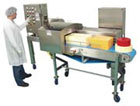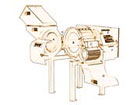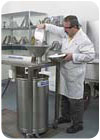

Yet the same expectations and demands placed by food processors on other categories of equipment come into play when product is being cubed, diced or ground into minute particles: safety features, for one, to minimize back strains from lifting components or the breathing of potentially combustible particles. Better sanitary design is another contemporary concern that is reflected in the latest versions of mills and slicers. And consistency, cost of operation and advanced controls are considerations that cut across all equipment categories, size reduction units included.
"Sanitation, maintenance and changeover are costs that all processors are trying to reduce," notes Lou Penta, marketing manager for Deville Technologies Inc., Montreal. "Machines that might have taken an hour to clean or changeover can now be serviced in a few minutes, thanks to quick-release parts and designs that stand up to high-pressure washdown." Increased throughput and reduced labor result in savings that drop directly to a processor's bottom line, he adds.
Touchscreen monitors for recipe management and fault detection are beginning to replace on-off buttons on some machines. Though still a rarity because of their cost, PC-driven controls allow plants to integrate shredders, dicers and other units with conveyors, tumble drums, scales and other equipment. They also help plants cope with the reality of less skilled workers who have replaced operators capable of judging performance by the pitch of a whirring motor.
Variable frequency drives to provide greater processing flexibility and larger impellers to eliminate precutting of larger ingredients are other changes being made by equipment fabricators at the request of individual customers. The most universal change, however, is sanitary improvements that meet the food safety concerns of processors.
"Customers increasingly are interested in sanitation," says Timothy H. O'Brien, vice president of sales at Valparaiso, IN-based Urschel Laboratories Inc. "The cost of product recalls is a major concern for processors. We don't want size reduction equipment ever to be a reason for one."
Urschel overhauled its food dicer unit with sanitation in mind. "There was a substantial amount of engineering done to come up with a design that isolates the food-contact zones," O'Brien says. "Companies are increasingly conscious of the sanitation of their machines."
Drive components were isolated in an area removed from the dicer's food zone, which is easily accessed for washdown. Other components are hinged to facilitate cleaning. A 21-in. diameter impeller facilitates throughput volumes comparable to older machines with much larger footprints, freeing up valuable floor space.
Hinged components are becoming a common feature in size-reduction machines partly because of another reality of today's workforce. Removing a 50-lb. part for cleaning can be daunting when a 5-ft. tall woman replaces a 6-ft. man as a machine operator, Deville's Penta observes. Tilt-back components on self-supporting hinges render brute force obsolete.
Waterloo, Ontario-based Quadro Engineering streamlined the design and eliminated crevices that can harbor bacteria when it developed the latest version of its Comil, a two-chamber machine that offers more gentle product handling than a hammer mill. A NEMA 4X enclosure is a standard feature in the U3 model machine. Disassembly of food-contact components is accomplished "in a matter of seconds," slashing changeover times, according to Wilf Sanguesa, Comil product manager.
"Some products need to be beat up with a hammer, including anything with a fibrous texture," allows Sanguesa. "But if you want to retain the nutrition, shape, flavor and size distribution of a product, you can't beat the Comil."

Compared to the current versions, mill classifying screens were comparatively crude a decade ago, says Sanguesa. "They used to be just round holes; now they work more like a slicing and cutting device," he says. By refining screen design, machine fabricators have been able to accelerate processing times, he adds.
As with the rest of the machine, screens need to be custom designed to allow appropriately sized particles to pass through without sticking, according to Scott Wennerstrum, technical director and marketing manager for Elmhurst, IL-based Fitzpatrick Company. At the same time, food companies are demanding greater flexibility from machines to process a broader array of products. To accommodate changeover, Fitzpatrick engineers designed a distinctive mounting system to ensure consistent clearance between the screen and the rotor, regardless of the particular screen being held in place.
Fitzpatrick and other major suppliers of size-reduction equipment maintain technical support groups to assist food processors in maximizing the potential of their machines. One of the more lengthy development projects involved Cozzini Inc.'s emulsion mill and brine system to create cold-particle suspensions for injection into meats (see "Development defines suspension systems," Food Engineering, May 2004). Introduced more than 20 years ago, the suspension systems had a checkered track record, with fat buildup clogging the meat injectors in many applications. Ultimately, Cozzini technicians identified the temperature of the suspension as the critical variable, though a multi-knife emulsifier replaced the earliest mills to optimize size reduction of trim meats fed into the system.

Special challenges
While milling and comminution are processes used in many industries, food poses special challenges in size reduction. Nutritionally oriented foods, spices and thermal sensitive sugar-based products may require cooling solutions either before or during grinding. Fibrous materials such as corn, oat hulls and many vegetables are prone to material buildup inside the grinding chamber. Screens or special blades often must be used.Cheese and other products with either high fat or moisture levels are another challenge. They tend to become sticky and adhere to the grinding chamber. Customized solutions often are necessary. Given the growth in sticky products such as energy bars and cheeses, equipment fabricators are spending more time and resources addressing those challenges.
Many size-reduction innovations are directed at pharmaceutical manufacturing, points out the Fitzpatrick Co.'s Wennerstrum. Particle containment is a greater concern for those processors because of the toxicology of medical ingredients, and drug makers are even more attuned to the sanitary considerations of their processes, generating demand for clean-in-place systems for dry ingredients. However, food manufacturers also are raising the sanitation bar in their processes, as well, and an innovation trickle down is almost inevitable.
Explosion-proof motors and other safeguards typically are built into mills and other size-reduction equipment. Those measures fall short of Europe's Explosive Atmospheres and Gassy Mines Directive, more commonly referred to as the ATEX Directive. "It's a regulation that has been around for awhile and goes further than explosion-proof electrical systems," explains Wennerstrum. Machines fabricated by the Fitzpatrick Co. and shipped to Europe have had to be ATEX compliant since July 2003, and equipment in use before that date must meet the higher standard by July 2006. The requirement is expected to touch off a wave of equipment retrofits and new equipment orders this year.
The standard can be met with a 12-bar enclosure, though that's not a practical solution for a mill with a continuous product stream, Wennerstrum says. A more workable solution involves purging the chamber of oxygen with nitrogen to starve an ignition of fuel. Many of the grandfathered European milling machines likely will be outfitted with nitrogen systems to create an inert environment for ATEX compliance.
Quadro also offers a nitrogen purge/oxygen analyzing system for its mills. If an independent lab recommends inerting the unit because of the ignition characteristics of the powder being sized, the end-user can opt for a simple open-loop system or a more sophisticated design using a pressure regulator, flowmeter and flow switch. If oxygen exceeds a predetermined level, a shutdown signal is sent to the mill controller. In either case, nitrogen feeds in through a small port in the infeed chute and takes advantage of nitrogen's heavier-than-atmosphere weight to flow down through the mill and exit through a vent port.
Vacuum conveying systems provide another solution to dust control. Besides reducing explosion potential and airborne pollutants in the processing area, vacuum can improve throughput. Sanguesa reports one pharmaceutical client lost thousands of pounds of product to dust prior to installation of a vacuum system.
While ATEX extends to all electrical and mechanical equipment with explosive potential and was prompted by efforts to apply uniform standards throughout the EU, ATEX's roots are in the mining industry, where explosions fed by airborne particles can be particularly lethal. West Virginia's Sago Mine disaster heightened awareness of those types of accidents and the need for explosion protection. It also raises a liability question for fabricators and users of size reduction equipment in the United States. While ATEX certification protects machine builders in the EU from civil penalties, litigation is the US remedy to workplace accidents. In time, domestically operated mills will meet the new standards, if only to minimize liability if injuries occur.
Keith Shackleford, Cozzini Inc., 773-478-9700
Lou Penta, Deville Technologies, 514-366-4545, lou@devilletechnologies.com
Scott Wennerstrum, the Fitzpatrick Co., 630-530-3333
Wilf Sanguesa, Quadro Engineering, 519-884-9660, wsanguesa@quadro.com
Tim O'Brien, Urschel Laboratories Inc., 219-464-4811
